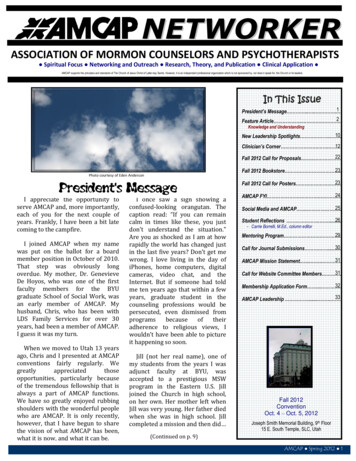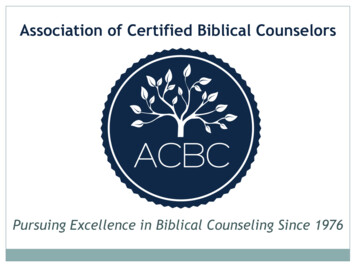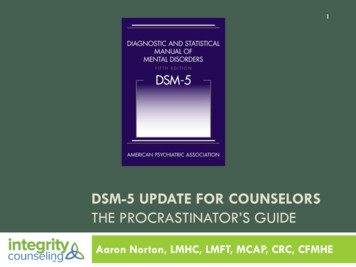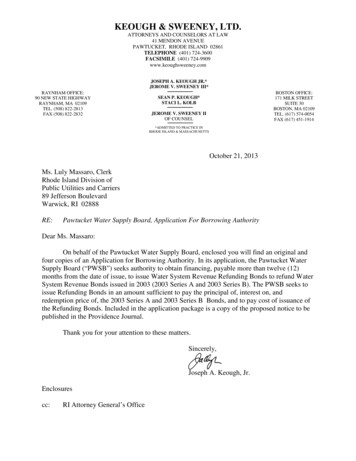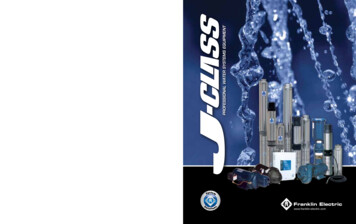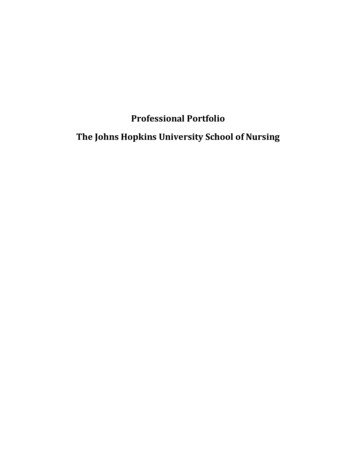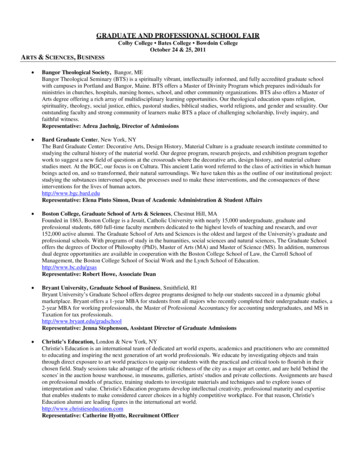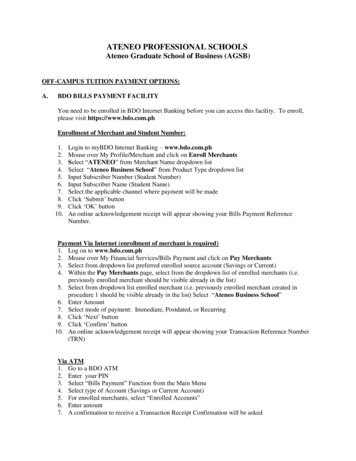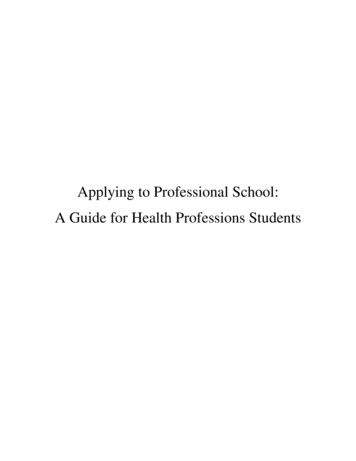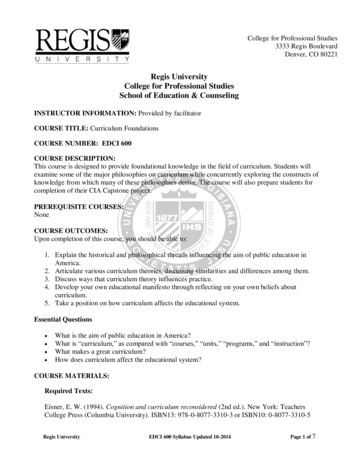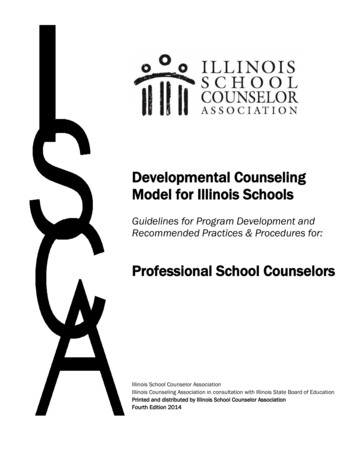
Transcription
Developmental CounselingModel for Illinois SchoolsGuidelines for Program Development andRecommended Practices & Procedures for:Professional School CounselorsIllinois School Counselor AssociationIllinois Counseling Association in consultation with Illinois State Board of EducationPrinted and distributed by Illinois School Counselor AssociationFourth Edition 2014
TABLE OF CONTENTSForeword .Prologue .A Brief History .Acknowledgements .A Special Message to Readers 456811Chapter 1: Introduction to Developmental Counseling in Illinois . .Rationale .Philosophy .Assumptions .Comparison 1415161617Chapter 2: Structural Framework .Active Description 1823Chapter 3: Foundation .Beliefs, Vision, Mission Statement .Needs Assessment .Developmental Goals Topics in Developmental Goals .Domain A: Academic Goals .Domain B: Career Goals .Domain C: Social-Emotional Goals Local, State and Federal Legislation .Additional Standards and Competencies 2428-31313333-343333-34343537-392
Chapter 4: Management . . 40Use of Data . . . 41Sequential Schedule/Calendar . . 43-49Use of Time . 50Annual Agreement . 52Steering Committee 53Chapter 5: Delivery .Direct Student Services . Individual Student Planning .Indirect Services . .Writing Lesson Plans . . .5657586061Chapter 6: Accountability . The Accountability Process . Types of Evaluations . .Types of Data . . .Benefits of the Accountability Process .Appendices References .References 1996 .63646465656787893
FOREWORDA key priority of the Illinois State Board of Education (ISBE) is to ensure that every student will besupported by highly prepared and effective school personnel. School counselors serve a critical role inensuring student success in meeting standards through the supports that they provide to children in and outof the classroom. School counselors are critical intermediaries for students whether they are choosingcollege, technical career preparation directly from high school, or further career exploration. Moreover,they must be prepared to address the transition needs for students for whom English is a second language,those with disabilities, those who are gifted and talented, those who are returning to education forcompletion of a diploma, even as adults, and those from advantaged and disadvantaged socioeconomicbackgrounds. Like the jobs of many education professionals, school counselor responsibilities are evolvingwith public education.Maintaining high expectations for all students is a component of fairness in education. High expectations,however, may remain elusive realities unless the social and emotional needs of each child are met. To thisend, ISBE adopted social and emotional learning standards in 2004 which further communicated theimportance of addressing the complex needs of developing human beings as a prerequisite to effectiveteaching and learning. School counselors are critical to this mission. The social and emotional developmentof children is so essential to academic success that, in addition to a guidance document produced byISBE, beginning in 2013, all programs that lead to licensure in Illinois are required to demonstrate howthey inform and instruct their candidates on the social and emotional r-education.htm).More specifically, the Developmental Counseling Model for Illinois Schools (2014) provides schoolcounselors with practices and procedures that will assist them to better serve all students. The developmentof this model has occurred because of the collaborative efforts of Illinois Counselor Educators andSupervisors (ICES), the Illinois School Counselor Association (ISCA) and ISBE. This fourth edition of theIllinois Model builds upon the work of previous editions, the work of those on the ISBE Student ServicesProviders Advisory Board and the national efforts of the American School Counselor Association Model. It ismy hope that this document will serve as a valuable resource for educators in Illinois.Thank you for your work on behalf of Illinois students. Your tireless support of children as they grow anddevelop their interests and as individuals is deeply appreciated.Christopher A. Koch, Ed.D.State Superintendent of Education4
PROLOGUEThis manual, The Developmental Counseling Model for Illinois Schools, hereafter referred to as the IllinoisModel, is prepared primarily for school counselors, but may also be used by teachers, school administratorsor school support personnel (SSP), parents and the business/industry community. This document is alsodesigned to be utilized in conjunction with pre-service training for students preparing to become licensedschool counselors in Illinois and those who desire to understand how the developmental model can be usedsuccessfully in schools. It is a handbook and guide for defining developmental counseling in Illinois schools.Updating the Illinois Model is seen as responsive to the changing needs of school counseling in the state ofIllinois. Since the 1996 edition was written, the world has gone through many changes which have had adirect impact upon the work of school counselors. School counselors work in three domains: (1) academic,(2) career and (3) social/emotional. State and federal legislation, especially the “No Child Left Behind Act,”has had a great effect upon the academic domain. The technological explosion and globalization of theinternet have added new meaning to career and post-high school planning. Perhaps the greatest impact ofall has been in the social/emotional domain. Violence in urban settings/tragedies such as Columbine, 9/11,Hurricane Katrina, Virginia Tech, Newtown and Northern Illinois University have touched the lives andhearts of Americans, especially our school children.The Illinois Model is a tool used in schools to assist counselors in guiding students through a developmentalcounseling program that is comprehensive, preventive in nature and focused on three domains: academic,career and social/emotional. The revision committee aimed to provide schools counselors in the field andpre-service counselors, with the knowledge and skills that are needed to work from a comprehensiveframework, coordinate activities and deliver lesson plans that will help all students to become productivelearners, to be competent contributors in their future careers and to develop into people who experiencesocial and emotional well-being.5
A BRIEF HISTORYThe planning and implementation of developmental counseling is not entirely new to the work of schoolcounselors. From the outset, school counselors provided individual and group counseling for students alongwith individual planning for academic and career development. In the 1960’s and 1970’s, counselors wereeducated to offer large group guidance activities. In fact, some schools were offering fairly extensive groupguidance activities. For example, Niles North High School in Skokie, Illinois offered a comprehensive groupguidance program that was highly developmental in scope. Curriculum projects were written in thesummers of 1965 and 1966, and counselors delivered the activities in 25-minute homerooms which metevery school day. Utilizing this format, counselors could see all students – freshmen, sophomores, juniorsand seniors - any day of the week. Programming covered academic, career and social/emotional topics forGrades 9 through 12.As school counselors advanced to guide more students in areas outside of career, educational organizationsalso worked to define the role of school counselors. In 1983 the Illinois State Board of Education (ISBE)published Pupil Personnel Services Recommended Practices and Procedures Manual: School Counseling.The goal was to outline the basic role and function of the school counselor. In this publication the role andfunction of the school counselor was described as the “Constellation of Services” model, and this descriptionwas in common use from the 1960’s through the early 1980’s. Critics of this model pointed out thatcounselors played an important but ancillary role in the total education of the student. Furthermore, thismodel was too oriented toward high school counseling and did not speak to how elementary and middleschool counselors had to function. Critics began talking of a different form of role and function for theschool counselor which is known today as Comprehensive School Counseling and/or Developmental SchoolCounseling.In 1994, in response to the national movement to create Developmental Counseling programs for schools,Illinois Counselor Educators and Supervisors (ICES) decided to develop a model for Illinois SchoolCounseling programs. In collaboration with the Illinois School Counselor Association (ISCA), theDevelopmental Counseling Model for Illinois Schools was published in 1996. In 2001, recognizing thechanging role and function of the school counselor, the Illinois State Board of Education Student ServicesProviders Advisory Board was charged to revise the 1983 Recommended Practices and Proceduresdocument. Under the direction of Eric Thatcher, then School Counseling Consultant for ISBE, and with thework of ISCA representatives Doug Bush, Cathy Shelton and Dr. Anna Marie Yates, and editorial input fromDr. Toni Tollerud, The School Counseling Best Practices Manual was created. This document reflected thecomprehensive and developmental philosophy for school counselors. Also, school counselors and counseloreducators became members of the Illinois Children’s Mental Health Partnership. This group’s work,through legislation, has had a positive impact upon our children and the counseling profession.The Developmental Counseling Model for Illinois Schools (2010) was meant to provide school counselorswith practices and procedures that would assist them to better serve all students. By utilizing the resourcesfrom the American School Counselor Association and the Illinois Learning Standards, the 1996 model wasintended to be a guide for counselors who are currently practicing in school settings.This edition (2014) was designed to update the model based on the ASCA National Model 3rd edition(2012) hereafter referred to as ASCA National Model and to be used as a supplement to the National Model.Therefore, an executive summary was added, language was modified to reflect new ASCA terminology andresources were updated and streamlined.6
Recognizing the First Illinois ModelWhen the first team of writers began in 1991, the task force agreed that there was no need to “recreate thewheel” in writing the Illinois Model. The writers concluded that there was an abundance of goodinformation already available to school counselors and that the task should be to combine the best of whatwas available into the Illinois document. However, as time went on, these writers found that they not onlyborrowed from many sources, but a number of areas took on uniqueness all their own, making this truly anIllinois Model. The references section reflects the variety of resources that were used. Specific resourceshave been identified because these were used in significant ways. The Illinois Model draws heavily from thework of Dr. Norman C. Gysbers, University of Missouri-Columbia; his contributions to this model and todevelopmental school counseling are significant. The first writers were also guided by state programs fromAlaska, Connecticut, Indiana, Iowa, New Jersey and Wisconsin.The 1996 Illinois Model also became a reality because of the work of a number of individuals and groups.The Illinois Counselor Educators and Supervisors, its leadership and members, must be recognized for thepromotion of the initial idea to write and financially support the model. The Illinois School CounselorAssociation must also be recognized for its direction, encouragement and generous financial support. TheIllinois Counseling Association needs to be recognized, because in 1993, it adopted this project as its ownand provided financial resources to support the effort. During the years of working on the 1996 model,numerous people provided various contributions to the effort at different stages. These individuals arerecognized within the Acknowledgements section.7
ACKNOWLEDGEMENTS2012-13 Revision Task ForceIn 2012, ASCA released a fourth edition of the ASCA National Model. Therefore, a team of ISCA membersset forth to update and streamline the 2010 model. Members of this 2012 revision team are as follows:Ms. Amelia Catania, School Counseling Graduate Student, DePaul UniversityMs. China Hill, School Counseling Graduate Student, National Louis UniversityMs. Ivy Malisow, School Counseling Graduate Student, DePaul UniversityMrs. Franciene Sabens, School Counselor, Chester High SchoolMrs. Tiffany Stallone, School Counselor, Niles North High SchoolDr. Melissa Ockerman, Counselor Educator, DePaul University, (Task Force Chair)Readers:Ms. Erin Vandermore, School Counselor, Chicago Public SchoolsDr. Christina Nolan, Counselor Educator, National Louis UniversitySpecial thanks to:Dr. Anna Marie Yates, Retired High School Counselor and Counselor Educator, National-Louis UniversityDr. Erin Mason, ISCA President, 2012Mary Carideo, College Counselor, ACE Technical Charter High SchoolDan Stasi, Executive Director, Illinois School Counselor AssociationRevision Team 2010A leadership council with representatives from the Illinois Counseling Association (ICA), Illinois CounselorEducators and Supervisors (ICES) and the Illinois School Counselor Association (ISCA) asked for a revisionof the 2009 Illinois Model. The president of each respective association invited readers and writers to jointhis revision team. The revision team members include the following:WritersDr. Venisa Beasley-Greene, School Counselor, Chicago Public SchoolsAmber Bolden, School Counselor, Evanston High School, Loyola University (Adjunct faculty)Dr. Erin Mason, Counselor Educator, DePaul UniversityDr. Dale Septeowski, Argosy UniversityDr. Anna Marie Yates, Retired School Counselor and Counselor Educator, National-Louis UniversityDr. Brett Zyromski, Northern Kentucky University (Team Chair)ReadersDr. Holly J. Nikels, Western Illinois UniversityDr. Chuck Pistorio, Northeastern Illinois UniversityDr. Toni Tollerud, Northern Illinois University8
The team extends a special thank you to the National-Louis University Administrators, who have alwayssupported the writing of this manual:Dr. Martha Casazza, Dean of the College of Arts and SciencesDr. Stephen Thompson, Associate Dean of the College of Arts and SciencesDr. Christopher Clemmer, Chair of the Counseling and Human Services DepartmentMany graduate students gave necessary and constructive editorial assistance. They are the following:National Louis University Students:David BakrinsAnna KlimkowiczNancy DavisAmy KonopasekAmanda DouglasMelissa RomeroMichael DrayerSheryl SierakowskiNoreen GarmischNancy SteinbergNichole GiovanniJoseph TranchitaJoely JohnsonAllison WasowskiArgosy Student: Jane Haskins WolfeIllinois Model 2005In 2005, a committee was formed and work commenced to revise the 1996 Illinois Model. Team memberswere serving on the leadership councils of the Illinois Counselor Educators and Supervisors (ICES) and theIllinois School Counselor Association (ISCA). The 1996 writers were also invited to participate in therevision process. Many individuals contributed time and expertise to this endeavor. The team members forthe Second Edition included the following:Ms. Maria McCabe, Retired Elementary School CounselorDr. Al Milliren, Counselor Educator, Governors State UniversityMs. Mary Milliren, Retired Elementary School CounselorMs. Roseanne Oppmann, Middle School Counselor, District 205 RockfordMr. Greg Stolzer, High School Counselor, District 99 Downers GroveDr. Dale Septeowski, Counselor Educator, Argosy UniversityDr. Rick Shaw, Retired Middle School Counselor and Counselor Educator, National-Louis UniversityDr. Anna Marie Yates, Retired High School Counselor and Counselor Educator, National-LouisUniversity (Team Chair)9
Illinois Model 1996Recognition for the 1996 Illinois Model is also extended to the following people. The contributions of thesepeople are what took the Illinois Model from the idea to reality. It was a significant amount of work andtheir efforts and contributions deserve special notice.Writing Team:Dr. Robert J. NejedloDr. Dale J. SepteowskiDr. Toni TollerudEditorial Team:Ms. Maria McCabeMr. Owen McCorkleDr. Robert J. NejedloDr. Dale J. SepteowskiDr. Toni R. TollerudMr. Larry WilliamsDr. Anna Marie YatesAlso, Mrs. Carla Luczak and Ms. Chris Kimball deserve a special thank you.10
A SPECIAL MESSAGE TO READERSThe school community is confronted daily with challenges that seriously interfere with the educationalprocess. The challenges in today’s society require school counselors to abandon traditional methods andadopt new, proactive approaches. The developmental counseling approach is proactive and encompassesand integrates prevention, remediation and crisis intervention methods to meet the needs of all students.This developmental counseling model offers a collaborative opportunity for all school staff, parents,guardians, and the community to contribute their own special expertise as it relates to the developmentalneeds of students. Counselors bear the major responsibility for the organization, coordination andprogramming of activities. Yet, to effectively achieve the goals of the Illinois Model in its fullest sense, otherschool support personnel (SPP), teachers, administrators and the community members must play asignificant role in its implementation.The hope is that every Illinois school will employ professional school counselors, who are available to assistall students in successfully navigating their academic experiences, assisting them in making informeddecisions concerning their career paths and supporting them as they learn to explore, understand andmanage their social/emotional development. Further in the future, school administrators, teachers andparents will understand that school counselors are vital members of the education team and a valuableresource as both a conduit between the school and the community and an important leadership teammember within the school.The authors of this revised model invite you to read this document and discover opportunities to work withschool counselors. We encourage you to become professionally involved in this innovative andcomprehensive approach to help all students prepare to become the next generation of parents, workers,leaders and citizens. Your support and input are essential. Together we can make a difference.11
Executive Summary“School counselors design and deliver comprehensive school counseling programs that promote studentachievement. These programs are comprehensive in scope, preventative in desi
guidance activities. For example, Niles North High School in Skokie, Illinois offered a comprehensive group guidance program that was highly developmental in scope. Curriculum projects were written in the summers of 1965 and 1966, and counselors delivered the activities in 25-minute homerooms which met every school day.
